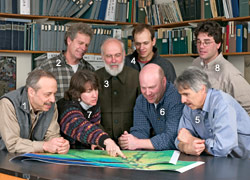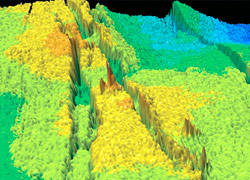|
You are here: Research
» Science Highlights »
Teamwork for discovering vents on the seafloor
Teamwork for discovering vents on the seafloor
|
|
 |
 Enlarge
image
Enlarge
image |
| Like
many expeditions involving WHOI scientists and engineers,
the cruises to the Lau Basin require a multidisciplinary
team. Participants on the September 2004 cruise included
engineers Dana Yoerger (1), Rod Catanach (2), Al Bradley
(3), and Joint Program engineering student Mike Jakuba
(4), as well as geologist Dan Fornari (5) and biologist
Tim Shank (6). Geochemists Meg Tivey (7) (who will be
the Chief Scientist) and Jeff Seewald (8) will participate
on the April 2005 return to Lau Basin, which will involve
deep-sea exploration with the remotely operated vehicle
Jason. (Photo by Tom Kleindinst, WHOI Graphics Services) |
 Enlarge
image
Enlarge
image |
| Vent spires rising 10 meters (33 feet) above the seafloor were found along fissures. |
Like deep-sea treasure hunters, the oceanographers
and engineers began their search with a rough map
and a few clues. They sought neither silver nor gold, but
hydrothermal vents in the Lau Basin, a previously unexplored area in the southwest Pacific Ocean.
“We knew there were vents, but we had to figure out exactly
where,” said Dana Yoerger, one of six WHOI researchers who
worked from the research vessel Kilo Moana in September
2004. “Our clues appeared in the form of smoke,” he said of
the buoyant plumes of warm, chemical-rich fluids that rise
from deep-sea vents and spread a few hundred meters above
the seafloor.
The vents offer a potential treasure trove
of information about how Earth works, and how deep-sea vent
organisms have adapted to thrive in these sunless places,
under extreme pressure and intense heat. The processes
that shape the Lau Basin are undergoing study through a series
of cruises that are part of the Ridge 2000 Program.
High-resolution
seafloor and plume maps made by a University of Hawaii group
were used to guide surveys by WHOI’s Autonomous Benthic Explorer
(ABE). ABE, a free-swimming robot used to locate the vents,
flew 10 to 300 meters (33 to 990 feet) above the seafloor
on a series of missions at six sites. The robot searched
for telltale changes in water temperature and chemistry that
signaled the presence of a vent.
In the image shown, at the
ABE vent site, the vent spires were about 10 meters (33 feet)
tall and located along fissures that crack the volcanic seafloor, allowing hydrothermal fluids to exit. ABE enabled
researchers to make detailed bathymetry maps of the site and
also collected digital images to document organisms living
at the vents.
The cruise was funded by the National Science Foundation
Ridge 2000 Program; four WHOI scientists were supported by
the Deep Ocean Exploration Institute.
|
|
Copyright ©2005 Woods Hole Oceanographic Institution,
All Rights Reserved.
Mail: Woods Hole Oceanographic Institution, 266 Woods Hole Road, Woods Hole,
MA 02543, USA.
E-Contact: info@whoi.edu; press relations: media@whoi.edu,
tel. (508) 457-2000
Home | Site Map | Contact
|

